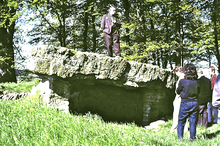Glyn Daniel


Glyn Edmund Daniel (23 April 1914 – 13 December 1986) was a Welsh scientist and archaeologist who taught at Cambridge University, where he specialised in the European Neolithic period. He was appointed Disney Professor of Archaeology in 1974 [1] and edited the academic journal Antiquity from 1958 to 1985. In addition to early efforts to popularise archaeological study and antiquity on radio and television, he edited several popular studies of the fields. He also published mysteries under the pseudonym Dilwyn Rees.
Early life and education
Daniel was born in Lampeter Velfrey, Pembrokeshire, a small village between Narberth and Whitland, in south-west Wales. His father, John Daniel, was the village schoolmaster there.[2] When Glyn Daniel was five he moved with his parents to Llantwit Major in the Vale of Glamorgan.[3] He attended Barry County School for Boys in Barry, where his academic ability led to him being awarded a State Scholarship (which he enabled him to go to the University of Cambridge) and a Glamorgan County Scholarship in 1931.[4] The Glamorgan County Scholarship allowed Glyn Daniel to study geology, and the church organ, at Cardiff University for a year.[5] In 1932 he went up to St John's College, Cambridge, where he remained for the rest of his academic career, to read archaeology and anthropology, and graduated with a first-class honours degree with distinction.[6]
World War II
During the Second World War, Daniel applied his talents at interpreting archaeological sites through aerial photography by working for the RAF's air photo unit at RAF Medmenham. He analysed and examined photos of enemy territory. In 1942 Daniel was sent to India to lead the Central Photographic Interpretation Section in Delhi, a mini-Medmenham for the South-East Asian theatre, ultimately achieving the rank of wing commander. A year after the war Daniel married one of his WAAF officiers, Ruth Langhorne.[7]
Career
After the war Daniel returned to Cambridge to resume his academic life. He became Disney Professor of Archaeology in 1974. From 1958 to 1985, he was editor of the academic journal Antiquity. His main subject of study was Neolithic chamber tombs, although he also wrote books on the history of archaeology and archaeological thought.
Daniel appeared on television. He was a host, often with Sir Mortimer Wheeler as a guest, on the game show Animal, Vegetable or Mineral?[8] He edited numerous popular studies of archaeological sites and cultures.
The McDonald Institute, University of Cambridge, have named the Glyn Daniel Laboratory for Archaeogenetics in his memory.
Academic works
- The Prehistoric Chamber Tombs of France (1960),
- The Megalith Builders of Western Europe (1963),
- 150 Years of Archaeology (1976), and
- a number of articles in archaeological journals.
- His most accessible work for the general public is The Idea of Prehistory (1962), later updated in collaboration with Colin Renfrew, Edinburgh University Press, 1988.
Detective fiction
Daniel wrote detective fiction under the pseudonym Dilwyn Rees. His novels The Cambridge Murders (1945) (later published in 1965 by Penguin Books under his own name) and Welcome Death (originally published under his own name in 1954) feature Sir Richard Cherrington, an eminent but slightly eccentric archaeologist who is the Vice-President of Fisher College – a character based on the author.[9]
References
- ↑ Colin Renfrew, ‘Daniel, Glyn Edmund (1914–1986)’, rev. Oxford Dictionary of National Biography, Oxford University Press, 2004.
- ↑ Glyn 1986, p. 9.
- ↑ Glyn 1986, p. 11.
- ↑ Glyn 1986, pp. 45-47.
- ↑ Glyn 1986, p. 48.
- ↑ Anon (19 March 1937). "University News: Awards at Oxford and Cambridge", The Times (UK).
- ↑ Taylor Downing, Spies In The Sky: The Secret Battle for Aerial Intelligence during World War II, Abacus, 2012 (2nd edition), 419 p, ISBN 978-0349123400
- ↑ Animal, Vegetable, Mineral?
- ↑ "Dilwyn Rees", Detective Fiction Website.
- Bibliography
- Daniel, Glyn. Some Small Harvest: The Memoirs of Glyn Daniel. London: Thames & Hudson, 1986. ISBN 0-500-01387-X
External links
- "Antiquaries in Wales", Amgueddfa Cymru – National Museum Wales
| Academic offices | ||
|---|---|---|
| Preceded by Grahame Clark |
Disney Professor of Archaeology, Cambridge University 1974–81 |
Succeeded by Colin Renfrew |